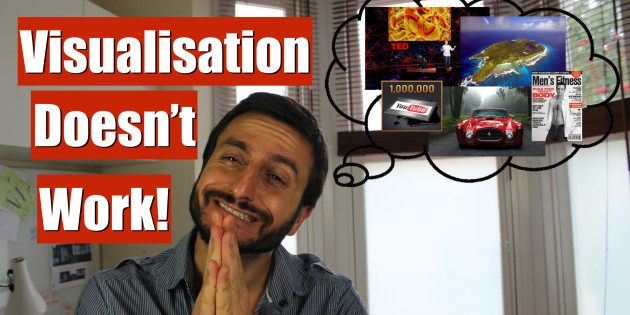Visualisation works. Or does it? In the video at the end of this blog I take the stance that it doesn’t work. And that’s because if you do it wrong, it can derail you.
What’s doing it wrong? We’ll get to that. First up – what is visualisation, in case you aren’t aware.
It’s the process of imaging before you do something how it’s going to pan out. And there’s a good (well many) reasons to do so. Firstly, the first time you do something it would be great if it went well for you, right? So why wait for the real thing. Visualise yourself giving an amazing presentation at work before you give it. Go through it a couple of times. Anticipate you answering Q&A questions cooly and with excellence.
Visualisation has been big in sport for decades. In fact, as far back as the 1930’s. There’s an extremely tight link between our visual system and physiology (how our body’s work). When we see ourselves doing something (especially if we’ve never done it before) we can usual pull it off we much higher odds. Harvard physiologist Edmund Jacobson first discovered this link back in the 1930’s in that imagining oneself lifting an object triggered corresponding electrical activity between the muscles involved in the lift.
And in 2004, Cleveland Clinic physiologist Guang Yue, conducted an experiment involving groups of people either strengthening their finger muscles through practice, or through visualising doing the exercise. The practising group increased strength by 53 percent, but interestingly for our purposes, the visualising group increased their strength too – by 35 percent! Even a group of participants asked to visualise increasing their arm strength increased it by 13.5 percent!
So we can conclude that visualisation can work.
However, here’s the big “BUT”. You can do it wrong if you just visualise the end result and not the process. In the examples above it’s obvious. You visualise only being stronger but not doing the exercise. For our presentation, we’re visualising the raptured applause but not the process of practising, writing the slides, answering the questions, researching the topic, opening the speech. You’ve got to visualise the process, behaviours and habits as these are what ultimately gets you to the goal.
That’s where I think that the movie The Secret falls down a little. It’s great that it introduced the world at large to The Law of Attraction, (including me) but in addition to making it seem that all you had to do is think of a red Ferrari and it would show up, it failed to emphasis both visualising the process and actions needed as well as emphasising that you action had to DO SOMETHING too. Apparently the teachers on film did talk about this, but it was edited out. We want easy solutions after all.
I think it’s best to think of The Law of Attraction written like this: The Law of Always Take Tremendous Repeated ACTION .
Researchers from the University of Pennsylvania discovered that just visualising the successes and not the obstacles and process along the way, meant that you would easier be discouraged and give up. It’s much better to visualise the process, the struggles, the obstacles and everything else that goes with getting the result rather than just the result. Still visualise the result too, but not just the result.
So next time you have an important presentation to do, or a pitch or maybe your running a marathon for charity, visualise the whole process.
What’s your experience with this? Let me know and remember to comment and share if you like it.










